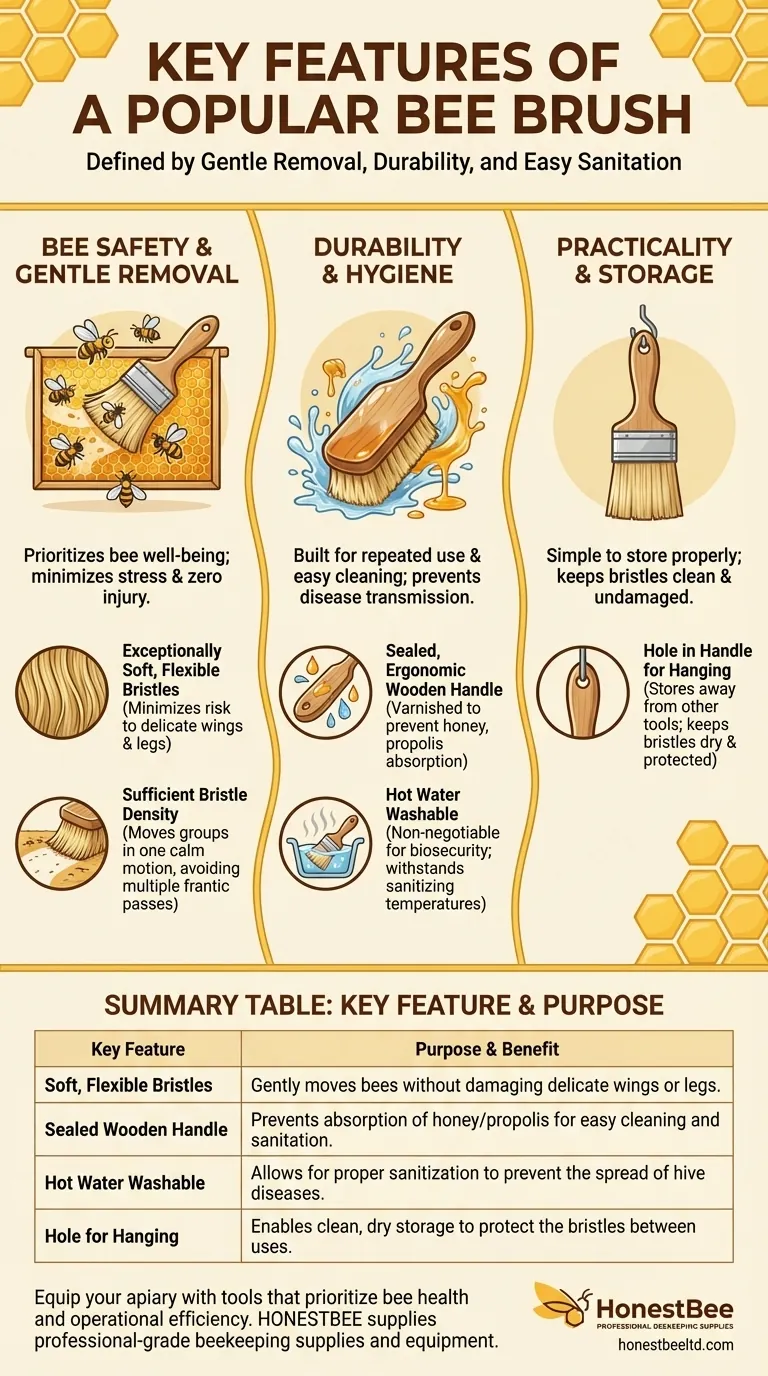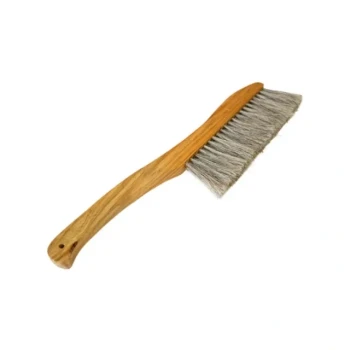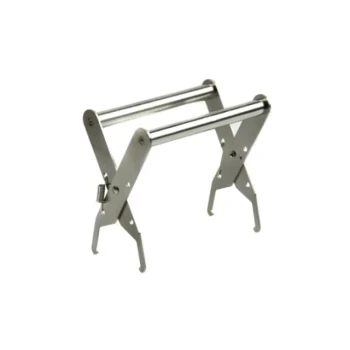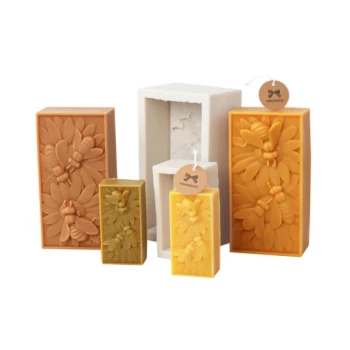A popular bee brush is defined by three core characteristics: its ability to gently move bees without harm, its durability for repeated use, and its design for easy sanitation. The key features that enable this are exceptionally soft bristles, a sealed and finished wooden handle, and the ability to be washed in hot water.
The purpose of a bee brush isn't just to move bees; it's to do so with minimal stress and zero injury to the colony. Therefore, its design must prioritize bee safety and hive hygiene above all other considerations.

The Core Principle: Gentle and Effective Bee Removal
A bee brush is a specialized tool, and its primary design consideration is the well-being of the bees. Every feature is built around the need to gently persuade bees to move from a surface, such as a frame of honey, without causing alarm or injury.
Soft Bristles for Bee Safety
The most critical feature is the use of soft, flexible bristles. These are typically long and natural, designed to feel more like a gentle push than a harsh sweep.
Stiff bristles, like those on a paintbrush or dustpan brush, can easily damage a bee's delicate wings or legs, rendering them unable to fly or forage. A proper bee brush minimizes this risk entirely.
Sufficient Bristle Density
An effective brush has enough bristle density to move a group of bees in a single, calm motion. Too few bristles will pass through the cluster, irritating the bees without effectively clearing them.
The goal is to use a single, slow sweep to clear the frame, which is less disruptive than multiple, frantic passes with an inadequate tool.
Designing for the Beekeeper: Hygiene and Durability
Beyond bee safety, a good brush must serve the practical needs of the beekeeper. This means it must be durable, easy to clean, and simple to store properly.
A Sealed, Ergonomic Handle
The handle is typically made of wood and is varnished or otherwise sealed. This is not an aesthetic choice; it prevents honey, propolis, and other hive materials from soaking into the wood.
A non-porous surface is crucial for cleaning and sanitation, preventing the brush from becoming a vector for disease transmission between hives.
The Critical Role of Washability
The ability to be washed in hot water is a non-negotiable feature for biosecurity. Beekeepers must be vigilant about preventing the spread of diseases like American Foulbrood.
Sanitizing tools between hive inspections is a fundamental practice, and a well-made brush is designed to withstand the hot water needed to do this effectively.
Practical Storage
A small but important detail is the hole in the handle for hanging. This allows the brush to be stored away from other tools, keeping the bristles clean, dry, and undamaged between uses.
Common Pitfalls to Avoid
Understanding the design of a proper bee brush also means recognizing what to avoid. Using the wrong tool can have negative consequences for your colony.
Avoiding Improvised Brushes
Never use a standard paintbrush, scrub brush, or any other household tool. These often have stiff, cut bristles that can harm bees and may contain chemical residues from manufacturing or prior use.
Knowing When Not to Brush
A brush is not always the best tool. For a frame with only a few bees, a sharp but gentle shake is often faster and less disruptive. Brushing is most effective when you need to clear a large population of bees from a surface you intend to remove, like a frame of honey during harvest.
Making the Right Choice for Your Apiary
Selecting a bee brush is a simple but important decision that reflects your approach to beekeeping.
- If your primary focus is bee safety: Prioritize a brush with the softest natural bristles you can find to ensure you never damage their wings or legs.
- If your primary focus is hive biosecurity: Confirm the brush is explicitly designed to be washed in hot water and has a fully sealed, non-porous handle.
- If your primary focus is efficiency: Look for a brush with a wide head and dense bristles to clear a frame with a single, gentle sweep.
Choosing the right brush demonstrates a beekeeper's commitment to the health and well-being of their colony.
Summary Table:
| Key Feature | Purpose & Benefit |
|---|---|
| Soft, Flexible Bristles | Gently moves bees without damaging delicate wings or legs. |
| Sealed Wooden Handle | Prevents absorption of honey/propolis for easy cleaning and sanitation. |
| Hot Water Washable | Allows for proper sanitization to prevent the spread of hive diseases. |
| Hole for Hanging | Enables clean, dry storage to protect the bristles between uses. |
Equip your apiary with tools that prioritize bee health and operational efficiency. HONESTBEE supplies professional-grade beekeeping supplies and equipment, including bee brushes designed for the rigorous demands of commercial apiaries and distributors. Our wholesale-focused operations ensure you get durable, hygienic tools that protect your investment. Contact our team today to discuss your supply needs and discover the HONESTBEE difference.
Visual Guide

Related Products
- Wooden Bee Brush with Triple Row Artificial Fiber for Beekeeping
- Wooden Bee Brush with Double-Row Horsehair Bristles
- Double Row Artificial Fiber Bee Brush for Beekeeping
- Classic Wooden Bee Brush with Double-Row Boar Bristles
- Premium Triple-Row Horsehair Bee Brush
People Also Ask
- What is the purpose of a bee brush? Gently Manage Your Hive with Precision
- What is a bee brush and what is its primary use? A Gentle Tool for Hive Management
- Why do beekeepers use a bee brush? The Essential Tool for Gentle Bee Handling
- What is a bee brush and how is it used in beekeeping? A Guide to Gentle Bee Handling
- What are some optional tools that can be useful in beekeeping? Boost Efficiency & Hive Health



















